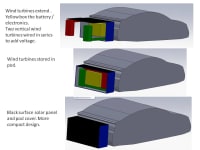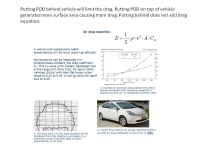Problem: Current gas and electric hybrid vehicles only recover 4% of the kinetic energy with regenerative braking. There are ideas based on capturing wind energy by mounting a wind turbine on the roof of hybrid vehicles. Mounting a wind turbine or any object to the roof of vehicle would increase the front cross sectional area of the vehicle which increases the drag forces. Increasing the drag forces lowers the fuel economy.
Solution: Hybrid Integrated Portable Power Pod (H.I.P.P.P.) is mounted just behind the back bumper with a trailer hitch. The HIPPP unit is designed not to be wider than the vehicle that it will be mounted to and mounting the HIPPP unit behind the vehicle does not increase the front cross sectional area used to calculate drag. The HIPPP unit deploys two vertical axis wind turbines at the same time for charging the hybrid vehicles battery or the HIPPP units own on board battery. When the vehicle is parked the HIPPP unit can retract the vertical axis wind turbines into the pod. The HIPPP unit is also covered with solar cells on its outer skin to collect solar energy. The Chevrolet Volt uses 8 kW-hr before switching to gasoline. With a 35 mile electrical range that works out to about 4.3 miles per 1 kW-hr. If the battery could be charged with just 1 kW-hr then the Volt could operate for another 4 miles on the battery electrical power. The HIPPP unit without increasing the aerodynamic drag would increase the hybrid vehicles distance traveled on the battery power vs. gasoline.
Application: The HIPPP unit's use on hybrid vehicles is a given. Conventional passenger vehicles could be fitted with a HIPPP unit to supply electrical power remote destinations where electrical power is not available. The HIPPP unit could be deployed in the suburbs and augment home electricity. Also during power outages the HIPPP unit could temporally supply back up electricity to run the heating system. Another potential use of the HIPPP unit is on small marine vessels. The HIPPP unit could be deployed on vehicles that are large enough so safely carry the HIPPP unit.
Path to Market: Currently looking at joining a business incubator to help bring HIPPP to the marketplace. Another pathway to the marketplace is licensing the technology to a big company that makes solar panels and small wind turbines.
Voting
-
ABOUT THE ENTRANT
- Name:Hoang Vo
- Type of entry:individual
- Software used for this entry:Solid Works & CFD
- Patent status:pending








